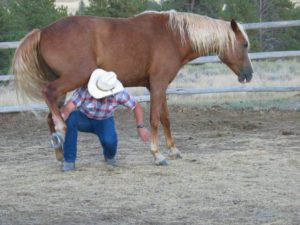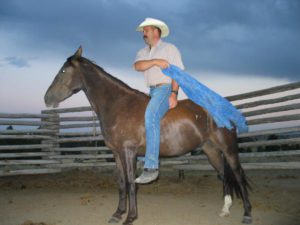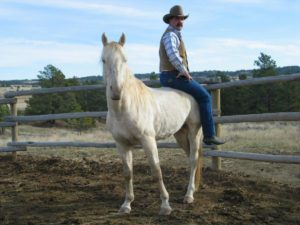Brandon Carpenter 2005
“What method do you use?” I am often asked this question when someone is unfamiliar with my horse training philosophy. The first time I was asked this a number of years ago; I wasn’t really sure what the gentleman was asking. I stood there with no idea how to answer. Those who know me well know what kind of feat making me speechless really is. Normally only banana fingered dentists have much success there. He rephrased the question and threw up a few now well-marketed names in the business. Understanding the question, I had to admit I had never seen any work these trainers had done. He went on to ask good pointed questions about how I achieve certain types of performance from my horses. I answered each question with as many of the common variations depending on the reaction of the horse as was practical. He commented that my methods were somewhat similar to several different trainers he had seen. At the time I only knew who one of them was. This was before mass marketing of training styles became as popular and well known as it is today.
The marketing of method training has become extremely successful the last 15 to 20 years. The horse training industry has reached full commercial scale. Everyone who can sell a tape or piece of tack that will make your horse do higher math on the first application is doing so and calling it “their method.” While many of these methods may be popular, I submit that they need to be scrutinized for their effectiveness. Not every horse will respond to training exactly the same way and turn out perfectly using the outlined instructions.

what it most needs based on its personality and behavior.
As a breeder, horseman and clinician there are several issues I have with what I call cookie cutter training. We need to remember that we are not the first, second or even tenth generation of folks who have played with the equine. There are many “methods” we are using that I am sure have been applied with varying levels of success for many centuries. I don’t believe we are doing much in the 21st century that hasn’t been thought of and attempted at some level eons before. We’re merely reinventing something unknown horsemen of the past took to their graves because they perhaps thought what they were doing was too evident to need share with anyone. The difference now is the ability to make a good living (or build an empire) by marketing and selling information regardless of the soundness of the product.
I believe there has been a general increase in the understanding of good horsemanship because of the commercialization. Unfortunately, I am disappointed concerning the level of application. One can’t possibly cover every varied reaction that every horse is going to bring to every training session on a 90-minute tape or even at a two-day clinic. This is where the downfall of the commercial approach to education lies.
I am always visiting with other horseman to beg, borrow, or buy information that will make me a more effective trainer and clinician. What I have noticed is an overwhelming number of people who use a cookie cutter training system. I have been told that in order to get a horse to___ you always ___. What they are telling me has absolutely nothing to do with the state of mind, condition, temperament, etc. of the horse as an individual. There is little consideration given to how the trainers’ actions affect the behavior of the horse. Emphasis is on the mechanics of forcing the horse to perform as quickly as possible. I believe the level of application needs to be improved, and can be done so with an increased understanding about the horse in general. The paradox is if more time were spent studying and understanding horses as herd animals and how they function as individuals in a herd, the training time would ultimately be less with much greater results.
I find this especially true when training gaited horses to walk naturally. By working with the horses’ individual personality I cue for responses based on its behavior to achieve a better gait. In other words, I pay attention to what the horse will mentally respond to best and use those cues to achieve physical performance. Some horses are more lateral and some are more diagonal in their gait. Changing the mechanical aspect of their gait is not done mechanically. I find it more beneficial to affect the mechanical aspect by working on their mental focus. The mechanics of the walk change based on how I affect the mental processes of the horse. I don’t rely on appliances, shoeing, or restraints to teach a fluid consistent walk. In spite of having different personality and physical types, the end result is having all those different horses gaiting the best each can consistently. Training in this way allows all the horses to work willingly with respect and trust. Seldom do any two horses react to training the same way, but they all achieve the goal of a relaxed consistent four beat gait in the end. The most important aspect of this training is lessons are taught through varied cues based on the horses’ behavior. The change in mental processes in turn affects physical performance. Training is ultimately done through the rational brain of the horse. The ultimate goal for each individual horse with different innate abilities is to master tasks that will cause them to react predictably similar to other horses that have mastered those same tasks. The end result of training must be the same, but achieved differently based on the difference in the personality of the individual. Using this flexible type of training provides for a behavior change that will more likely last their lifetime.

insures consistent dependability and safety .
There is a lot of talk by many clinicians about how to be a partner with your horse. This sounds noble and without ego yet consequently sells tapes, DVD’s, tack, and various other sundries to accomplish this partnership. However, when you pay attention to how the methods or techniques are applied, a conquering attitude is often revealed. Little regard for the horse as an individual is taken into consideration in the communication process. The communication is one way, from trainer to horse. Most feedback the horse is giving is either not seen or largely ignored. Successful training is viewed as being about quick results regardless of the mental and emotional state of the horse. The prevailing attitude seems to be the faster the results, the better the trainer. Fast results also help sell products the trainer has available. What is missed is the difference between quick results and long term entrenched learning on the part of the horse.
One well-known clinician says with regard to training, “repeat this [lesson] seven times in a row, and you’ll have taught your horse a habit.” I seriously disagree. Seven is not a magic number for all horses to learn something new and make into habit. The only thing that has been accomplished is performing a task seven times in a row at that specific time. When I am teaching a horse to gait consistently, I know they haven’t made it habit simply because they took seven consistent steps or even walked consistently seven different times during a specific ride. Teaching something to the point it becomes a habit takes consistent repetition over time. Horses are individuals that learn at different rates and in different ways. One horse may indeed learn something new in a couple of applications, but another horse may need to repeat the same lesson many many times before it becomes habit. I believe the reason this clinician is so popular is because he slyly markets simplicity. He makes horse training sound like cutting out and baking cookies. All you need to do is follow the recipe at home. Add the ingredients, stir, roll the dough, stamp out horse shapes, bake for 18 minutes and poof instant-trained horses. This works especially well when you purchase his halter, endorsed bit, or other regalia that works every time on every horse.
I can’t tell you the number of horse owners that have asked me to fix their horse after they attempted to follow the tapes and use the tack they bought at a clinic. By the time they contact me they are having serious problems with a horse that was promised to be able to be trained by following the clinicians program. The problem is the only thing that was taught on the tape was mechanics of forcing the horse do what you want. Nothing was conveyed about subtle horse behavior and what it means, how it affects behavior, how you affect behavior, etc. Why is this so common? There are no absolutes when you approach training as communication between two individuals of different species. All possible variables cannot be put down on tape and sold to the general public in the 90-minute format. Training suddenly becomes more undefined and nebulous. Unfortunately that’s the way it is in the real world. Understanding horses means to understand horse behavior and communication especially in its subtlest form. That’s where the most effective tool for training lies. Listen to your horse as an individual. Understand how you continually affect that individuals behavior and work diligently and consistently during every aspect of interaction. Watch, listen, feel and be aware of yourself and the horse. The horse will read subtle cues you give, and it will begin to react in kind to your light communication. You will build a great relationship through training in this manner and your horse will be more responsive because of it.
There is no recipe that works quickly every time on every horse with exactly the same results. That recipe causes the cookie to crack and crumble when little pressure is applied. Sound, thorough, flexible training without shortcuts from the very beginning produces great horse performance.
I don’t think it is really possible to get the absolute best performance out of any horse by ignoring or at least not having a limited consideration of the base behavior of the horse itself. This base behavior is in turn often greatly influenced by the attitude and actions of the trainer or handler.
Here is an illustration in human terms. Lets say a group of men are visiting about their home life, and boasting about how they make all the important decisions in the household. They are generally pretty supportive of each other’s similar role. A couple may even add an anecdote or two to drive their point home. They tend to get each other pumped up to full superiority in short order. Each individual has affected all of the others behavior and his has been affected in turn. Enter a wife of any one of these giants of machismo and you can immediately see and feel the change in at least one personality. Most likely the “little lady” can cause this change just through her presence. She doesn’t have to be privy to the conversation, only put in the mix of personalities to change the tone. Her presence not only changes her husbands’ demeanor, but suddenly the demeanor of all involved without even a word spoken. How many times have you seen this sort of change occur?
The same thing happens in what I call a herd of two; a herd that consists of you and your horse. Change constantly occurs because of the interaction between just the two of you. Know and understand these subtle and not so subtle changes, why they surface and how it affects the communication. Learn how to use it to your advantage to provide depth of training for your horse. Don’t be afraid to invest time into the training. Solid training results through repetition of a desired behavior done with consistency and followed with timely reward. A quick result achieved in a clinic setting is not training. It is a demonstration of what needs to continue to create habit.

There also is what I call the mystical clinician. This is the individual that shows the clinic attendees how effective his methods are by getting several horses he has never before seen, do exactly as he wishes. He predicts with some accuracy the timeline in which the horses will do what he wants them to. This impresses the folks who are certain they have made the right choice in dropping several hundred hard-earned dollars to garner the secrets he has to reveal. In addition, if they purchase the gizmos that he is using in the demonstrations they can’t go wrong in their desire to be a great trainer. What is not said is what is obvious and predictable about the clinic setting. Most are held at a place where the participant has not had their horse prior to that day. There is a lot of activity with people, strange horses, noises and sights not experienced before. Because of the overwhelming stimulus, the horse wants to find comfort in the herd setting. If the only other herd member is the human that is in the arena, so be it. The horse will bond very quickly with the clinician and strive to find placement in the herd of two. When I teach clinics I feel it is my responsibility to point out why the horse will be so predictable and why I can achieve results so quickly. There is nothing mystical about what is done at the clinic; a lot of it is the setting effect on the horses’ natural behavior. When the owner gets the horse home and tries the same techniques, it often won’t work as well because the horse is comfortable and not overwhelmed. The techniques will work, it just takes more patience and attention because of the difference in the horses state of mind. Don’t be confused by the ease of results at the clinic. It isn’t always the effectiveness of the technique that is used; most of it can be attributed to the sensory overload of the horse.
Learn how to “read” your horse and work with it constructively. Customize the training to fit the personality and demeanor as well as mental and emotional well being of the horse. This will cause the horse to learn in leaps and bounds and be more willing to work for you. You will find working with an individual horse is no different than relating to other humans. Treat them as the individuals they are and listen to what they are telling you. Change training lessons based on the individual needs of the horse. Don’t let the horse train you, but rely on it to show you how it will best assimilate the training you provide. The trust you develop by working with the horses natural “being” will allow you to do things you never thought possible with a young horse. You will foster a much deeper relationship in which you can guide the training to the highest levels of performance. Performance that will shine whether in the show ring, working cattle, lining out in a pack string, or hitting a four beat gait on a mountain trail.


